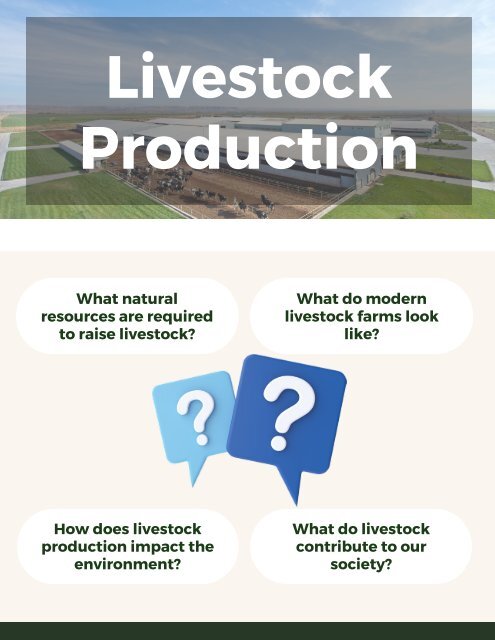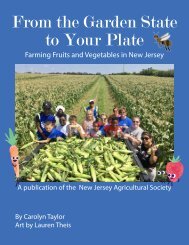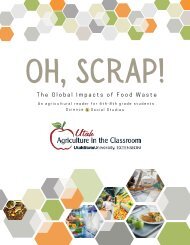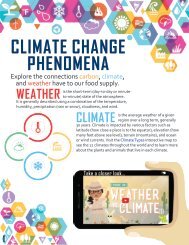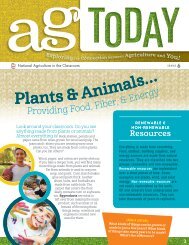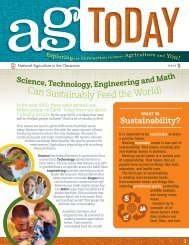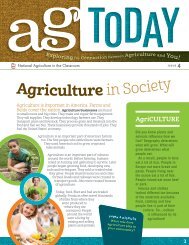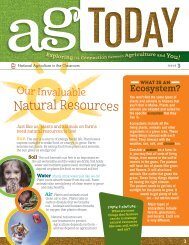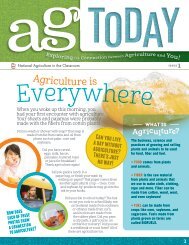Livestock Production
Create successful ePaper yourself
Turn your PDF publications into a flip-book with our unique Google optimized e-Paper software.
<strong>Livestock</strong><br />
<strong>Production</strong><br />
What natural<br />
resources are required<br />
to raise livestock?<br />
What do modern<br />
livestock farms look<br />
like?<br />
How does livestock<br />
production impact the<br />
environment?<br />
What do livestock<br />
contribute to our<br />
society?
Dairy<br />
The dairy industry contributes to food<br />
security by supplying a significant source of<br />
protein, calcium, and essential vitamins<br />
through milk, cheese, yogurt, butter, and<br />
other dairy products.<br />
Virtual<br />
Life Cycle of Milk<br />
<strong>Production</strong><br />
Field Trip<br />
Dairy cows are raised and cared for on farms.<br />
After the birth of a calf, cows begin producing<br />
milk and the calf is raised. Some female calves<br />
are used for replacement in the herd while<br />
others are reared for meat production. Milk is<br />
collected through milking machines. The milk is<br />
then transported to processing facilities where it<br />
undergoes pasteurization, homogenization, and<br />
packaging. The final dairy products, including<br />
milk, cheese, yogurt, and butter, are distributed<br />
to consumers through various retail channels.<br />
Throughout this cycle, animal care, nutrition,<br />
environmental management, and ethical<br />
considerations play crucial roles in ensuring<br />
sustainable and responsible milk production.<br />
1<br />
2<br />
3<br />
UPCYCLE WASTE<br />
Click on underlined<br />
words for hyperlink<br />
Cows can digest waste from the food<br />
processing industry and transform it into<br />
nutrient-dense food products. Without<br />
cattle, the waste would go to a landfill.<br />
GENERATE RENEWABLE ENERGY<br />
Methane gas, when captured and<br />
transformed from manure waste, can be<br />
utilized to generate renewable energy,<br />
offering benefits such as reducing<br />
greenhouse gases and air pollution.<br />
SUPPLEMENT SOIL NUTRIENTS<br />
Cattle manure, a natural source of soil<br />
nutrients, serves as sustainable fertilizer<br />
for crop growth.<br />
4<br />
CONTRIBUTE TO BEEF SUPPLY<br />
Dairy cattle contribute both meat and<br />
dairy products, supplying around 20% of<br />
the U.S. beef supply. 1
<strong>Production</strong> Styles<br />
The majority of dairy farms in the U.S.<br />
are conventional. They use modern<br />
agricultural practices to feed and care<br />
for animals. Most are housed in freestall<br />
barns or dry lots and fed harvested<br />
forage/grain.<br />
Find out how<br />
many dairy cows<br />
are in your state.<br />
Some dairies are certified organic by<br />
following regulations concerning the<br />
use of antibiotic medication, feeding,<br />
and housing practices.<br />
Organic dairies are required to offer<br />
grazing for a certain number of days<br />
per year as determined by their<br />
climate. Some conventional dairies<br />
graze their cattle as well.<br />
Use the code on<br />
the container<br />
and find out!<br />
Environmental Impact<br />
The environmental impacts from the dairy<br />
industry that need to be sustainably<br />
managed include:<br />
Water Pollution: Improper manure<br />
management can run off fields,<br />
contaminate water sources, cause algal<br />
bloom, and damage aquatic ecosystems.<br />
Greenhouse Gas Emissions: Cattle<br />
contribute to GHG emissions. Managing<br />
emissions is essential for mitigating<br />
climate change.<br />
Air Quality: <strong>Livestock</strong> operations can emit<br />
ammonia and particulate matter, affecting<br />
local air quality and creating odors.<br />
NATURAL RESOURCE USE<br />
WATER<br />
ENERGY<br />
Dairy products carry a<br />
significant water footprint<br />
requiring an estimated 95<br />
gallons of water for each<br />
serving.<br />
Automated equipment,<br />
milk cooling systems, and<br />
other operations consume<br />
fossil fuel energy.<br />
Land is required to house<br />
the cows and calves as well<br />
as fields to grow forage and<br />
grains for feed.<br />
LAND<br />
SOIL NUTRIENTS<br />
Cattle eat hay and a mixture<br />
of grains. These fields<br />
require arable soil and<br />
replenished soil nutrients<br />
through the application of<br />
manure or synthetic<br />
fertilizer.
Beef<br />
The beef cattle industry contributes to global food<br />
security, providing a reliable source of protein and<br />
essential nutrients. When properly utilizing grazing<br />
lands, the beef industry also maintains ecosystems and<br />
helps prevent land degradation.<br />
Virtual<br />
Life Cycle of Beef<br />
<strong>Production</strong><br />
Field Trip<br />
Beef cattle are raised on farms and ranches.<br />
These cattle undergo breeding and reproduction<br />
processes, leading to the birth of calves. Calves<br />
are nurtured and raised by their mothers while<br />
spending the majority of their lives grazing<br />
public or private land. As they mature, cattle are<br />
typically sent to feedlots for finishing where they<br />
are fed a diet designed to promote muscle<br />
development. Finally, the cattle are harvested at<br />
processing facilities where they are butchered<br />
into various cuts of beef that are packaged and<br />
distributed to consumers. Throughout this<br />
lifecycle, proper animal care, nutrition, and<br />
environmental management are critical<br />
elements for sustainability.<br />
1<br />
2<br />
3<br />
UPCYCLE WASTE<br />
PROVIDE BYPRODUCTS<br />
Click on underlined<br />
words for hyperlink<br />
Cows can digest waste from the food<br />
processing industry and transform it into<br />
nutrient-dense food products. Without<br />
cattle, the waste would go to a landfill.<br />
Meat is the primary product of the beef<br />
industry, but cattle also contribute to<br />
numerous secondary products, known as<br />
“byproducts.”<br />
REGENERATE SOIL & GRASSLANDS<br />
Herbivores play an essential role in<br />
building soil that can hold more water<br />
and absorb carbon from the atmosphere.<br />
4<br />
USE MARGINAL LANDS<br />
Marginal lands are considered low value<br />
due to poor soil, steep terrain, or low<br />
water availability. 65% of lands used for<br />
cattle grazing cannot be used to grow<br />
crops. 2 Cattle convert low-value grass to<br />
high-value protein.
<strong>Production</strong> Styles<br />
All beef cattle spend most of their lives on<br />
open land eating grass. Most cattle move<br />
to feedlots to be fed harvested hay and<br />
grain during their last stage of growth to<br />
speed growth and add tenderness and<br />
flavor to the final beef product.<br />
Find out how<br />
many beef cows<br />
are in your state.<br />
The majority of beef cattle ranches in<br />
the U.S. are conventional. Some follow<br />
protocol to certify as organic by<br />
following specific requirements in<br />
regard to health care and feed.<br />
All beef cattle are grass-fed for the<br />
majority of their lives. Some are also<br />
“grass-finished” which means they<br />
are not fed grain at a feedlot for their<br />
final stage of growth before harvest.<br />
Environmental Impact<br />
The environmental impacts from the beef<br />
industry that need to be sustainably managed<br />
include:<br />
Land Degredation: Overgrazing and<br />
improper land management can lead to soil<br />
erosion, reducing soil fertility and impacting<br />
land productivity.<br />
Greenhouse Gas Emissions: Cattle emit<br />
methane, a potent greenhouse gas, during<br />
digestion and manure decomposition.<br />
Methane contributes to global warming and<br />
climate change.<br />
Waste Management: Improper<br />
management of manure and waste from<br />
feedlots can lead to odors, water<br />
contamination, and the attraction of pests.<br />
NATURAL RESOURCE USE<br />
WATER<br />
FORAGE & FEED<br />
LAND<br />
Beef products have a large<br />
water footprint estimated at<br />
465 gallons of water to<br />
produce every serving. 94%<br />
of this water is rainwater.<br />
Quality forage, including<br />
grasses and hay, are<br />
essential for cattle<br />
nutrition. Feed crops<br />
provide proper nutrition<br />
for growth.<br />
Ample land is required for<br />
grazing cattle and growing<br />
feed crops such as pasture<br />
grasses and hay.<br />
Good air quality and a<br />
suitable climate are<br />
necessary for cattle comfort<br />
and health.<br />
AIR & CLIMATE
Pork<br />
Pork farms offer a source of protein and essential<br />
nutrients by providing various cuts of pork for<br />
consumption. Additionally, the industry supports<br />
livelihoods throughout the supply chain, from pig<br />
farming and processing to distribution and retail.<br />
Virtual<br />
Life Cycle of Pork<br />
<strong>Production</strong><br />
Field Trip<br />
The lifecycle of pork production begins with the<br />
breeding of pigs on farms. Sows give birth to<br />
piglets, which are nurtured until weaning. After<br />
weaning, piglets are raised in specialized barns<br />
where they are provided a balanced diet for<br />
growth. As pigs mature, they are transferred to<br />
finishing barns where they are fed a diet<br />
designed to promote muscle development.<br />
Finally, the pigs are harvested at processing<br />
facilities, where they are butchered into various<br />
pork cuts that are packaged and distributed to<br />
consumers. Throughout this lifecycle, proper<br />
animal care, nutrition, and environmental<br />
management are essential to sustainable and<br />
responsible pork production.<br />
1<br />
2<br />
3<br />
PROVIDE BYPRODUCTS<br />
Pork processing provides a wide range<br />
of products used in everyday life<br />
including leather, gelatin, pet food,<br />
glycerin, and more.<br />
Click on<br />
underlined<br />
words for<br />
hyperlink<br />
GENERATE RENEWABLE ENERGY<br />
Methane gas from manure waste can be<br />
captured and transformed into<br />
renewable energy while also decreasing<br />
greenhouse gases and air pollution.<br />
SUPPLEMENT SOIL NUTRIENTS<br />
Manure from pigs (and other livestock) is<br />
a natural source of soil nutrients or<br />
fertilizer that can be used on fields to<br />
replace depleted nutrients.<br />
4<br />
MEDICAL RESEARCH<br />
Pigs provided the first insulin for<br />
diabetics. The structure of the pig heart<br />
is similar to humans. Pork heart valves<br />
have been used successfully to replace<br />
diseased valves in humans.
<strong>Production</strong> Styles<br />
The majority of pig farms in the U.S.<br />
house their pigs in climate-controlled<br />
barns. This housing style uses<br />
sophisticated technology to maintain<br />
air quality, manage manure waste,<br />
and provide a consistent climate.<br />
Find out how<br />
many pigs are in<br />
your state.<br />
There are a relatively small number of<br />
organic certified pig farms in the<br />
United States. They follow<br />
requirements such as using organic<br />
feed, providing outdoor access, and<br />
prohibiting antibiotics.<br />
There are a small portion of pig<br />
farms that specialize in offering free<br />
range, outdoor housing for pigs. This<br />
housing style offers more space for<br />
pigs, but also proves challenging in<br />
colder climates.<br />
Environmental Impact<br />
The environmental impacts from the<br />
pork industry that need to be<br />
sustainably managed include:<br />
Water Pollution: Improper manure<br />
management and runoff from pig<br />
farms can lead to water pollution and<br />
contaminating water bodies with<br />
pathogens and organic matter.<br />
Air Pollution: Improper handling and<br />
storage of pig manure can lead to<br />
odor issues and release of GHGs (such<br />
as methane and nitrous oxide),<br />
Land Use: The pork industry requires<br />
substantial amounts of land for feed<br />
crop production, which can<br />
contribute to deforestation, habitat<br />
loss, and land degradation.<br />
NATURAL RESOURCE USE<br />
WATER<br />
FEED CROPS<br />
LAND<br />
Pork products have a large<br />
water footprint estimated at<br />
180 gallons of water to<br />
produce every serving. 82%<br />
of this water is rainwater.<br />
Pigs are fed protein-rich<br />
grains. Crops such as corn,<br />
soybeans, wheat, and barley<br />
are grown to provide the<br />
necessary nutrients for pig<br />
nutrition.<br />
Space is needed for pig<br />
housing, outdoor areas, and<br />
feed crop cultivation.<br />
Proper ventilation and air<br />
quality management are<br />
essential for pig comfort<br />
and health.<br />
AIR & CLIMATE
Eggs<br />
Egg farms provide a consistent supply of high-quality,<br />
protein-rich eggs. These farms contribute to nutrition<br />
and food security, offering a versatile ingredient used in<br />
a wide range of culinary applications. The industry also<br />
supports economic livelihoods and jobs in farming,<br />
processing, and distribution. Egg production is efficient<br />
in terms of feed conversion and utilizing resources<br />
effectively to produce a nutrient-dense food source.<br />
Virtual<br />
Life Cycle of Egg<br />
<strong>Production</strong><br />
Field Trip<br />
The lifecycle of egg production begins with<br />
hens that are raised in specialized barns. Hen<br />
housing can include cages, cage-free aviaries,<br />
or free range housing. These hens undergo<br />
natural reproductive processes, leading to the<br />
laying of eggs. The eggs are collected daily and<br />
carefully managed to maintain their quality<br />
and freshness. After collection, eggs are<br />
cleaned, inspected, and packaged for<br />
distribution to consumers. Throughout this<br />
lifecycle, proper animal care, nutrition, and<br />
biosecurity measures are crucial to ensure the<br />
well-being of the hens and the production of<br />
safe and nutritious eggs.<br />
1 1<br />
2<br />
3<br />
BAKERY & FOOD SERVICE<br />
Eggs are needed for a wide variety of<br />
foods. The entire bakery industry relies<br />
on eggs to serve as a thickener, binding<br />
agent, and leavening agent.<br />
ECONOMIC PROTEIN SOURCE<br />
Eggs are often the most affordable<br />
source of protein when calculating<br />
average prices with grams of protein<br />
contained.<br />
SUPPLEMENT SOIL NUTRIENTS<br />
Manure from chickens (and other<br />
livestock) is a natural source of soil<br />
nutrients and fertilizer that can be used<br />
on fields to replace depleted nutrients.
<strong>Production</strong> Styles<br />
The majority of laying hens in the U.S. are<br />
housed in a conventional cage system<br />
where hens are housed in small group<br />
cages inside large, climate-controlled<br />
barns. The barns have sophisticated<br />
technology to collect eggs, provide feed<br />
and water, and remove manure.<br />
Find out how many<br />
laying hens are in<br />
your state.<br />
Egg farms have more diversity in their<br />
housing style than any other livestock.<br />
In addition to conventional cage<br />
systems, there are also cage-free<br />
aviaries, free-range systems, and<br />
pasture systems to house laying hens.<br />
Organic egg farms follow<br />
regulations in their feed selection,<br />
housing style, and healthcare. Most<br />
of the labels found on egg cartons at<br />
the grocery store refer to the<br />
housing system the hens live in.<br />
Environmental Impact<br />
The environmental impacts from the egg<br />
industry that need to be sustainably<br />
managed include:<br />
Manure Management: Managing the<br />
manure produced by laying hens is<br />
critical. Improper handling and disposal<br />
can lead to nutrient runoff, water<br />
pollution, and odors.<br />
Air Emissions: Ammonia emissions<br />
from manure can contribute to air<br />
pollution, affecting air quality and<br />
potentially causing respiratory issues in<br />
both animals and humans.<br />
Waste Generation: Egg production<br />
generates waste materials, including<br />
eggshells and packaging waste.<br />
Managing waste responsibly is essential<br />
to minimize environmental impacts.<br />
NATURAL RESOURCE USE<br />
WATER<br />
ENERGY<br />
LAND<br />
Eggs have a large water<br />
footprint estimated at 98<br />
gallons of water to produce<br />
every serving. 79% of this<br />
water is rainwater.<br />
Energy is required for<br />
lighting, heating, ventilation,<br />
and egg processing. These<br />
non-renewable energy<br />
sources contribute to<br />
carbon emissions.<br />
Space is required for hen<br />
housing, outdoor access if<br />
applicable, and cultivation<br />
of feed crops.<br />
Hens are provided with a<br />
balanced diet that includes<br />
grains, protein-rich crops,<br />
and other feed ingredients.<br />
FEED CROPS
Lamb<br />
The lamb industry plays a significant role in providing<br />
nutrient-rich protein and contributing to diverse diets and<br />
culinary traditions worldwide. Beyond its culinary value, the<br />
industry supports rural economies, provides livelihoods for<br />
farmers and related sectors, and contributes to sustainable<br />
land use through grazing management. Byproducts such as<br />
wool and leather also have various applications, while sheep<br />
farming can help maintain open landscapes and biodiversity.<br />
Virtual<br />
Life Cycle of Lamb<br />
<strong>Production</strong><br />
Field Trip<br />
The lifecycle of a lamb begins with ewes that<br />
are raised on farms. Ewes undergo breeding<br />
and reproduction processes, resulting in the<br />
birth of lambs. Ewes and lambs are raised on<br />
grazing lands where they consume a diet<br />
primarily consisting of grasses. Lambs can<br />
mature on grazing or in a feedlot until they<br />
reach market weight, at which point they are<br />
harvested at processing facilities. The meat is<br />
then processed into various lamb cuts that are<br />
packaged and distributed to consumers.<br />
Throughout this lifecycle, proper animal care,<br />
nutrition, and environmental management are<br />
crucial to ensuring sustainable and responsible<br />
lamb production.<br />
1 1<br />
2<br />
3<br />
PRODUCE WOOL<br />
Click on underlined<br />
words for hyperlink<br />
Sheep are a valuable source of wool, a<br />
natural fiber used in textiles. Without<br />
wool we would rely on synthetic fibers<br />
made with non-renewable resources.<br />
DO NOT REQUIRE GRAIN<br />
Sheep can reach prime condition by<br />
eating forage alone. They do not require<br />
grains to reach the proper meat-fat<br />
ratio for quality meat cuts.<br />
USE MARGINAL LANDS<br />
Marginal lands are considered low value<br />
due to poor soil, steep terrain, or low water<br />
availability. Sheep grazing contributes to<br />
ecosystem balance and uses land that isn’t<br />
suitable to other types of agriculture.<br />
4<br />
MITIGATE FIRE RISK<br />
Excessive plant growth fuels wildfires.<br />
Lands that have been grazed by livestock<br />
have a lower risk of burning out of<br />
control.
<strong>Production</strong> Styles<br />
Sheep spend the majority of their lives on<br />
open land eating grass. Some sheep move<br />
to feedlots to be fed harvested hay and<br />
grain during their last stage of growth, but<br />
sheep can be range-finished. The<br />
determining factor is the weather and<br />
quality of range available.<br />
Find out how<br />
many sheep are<br />
in your state.<br />
A niche market in the lamb<br />
industry is for organic lamb.<br />
Farmers who sell organic labeled<br />
lamb follow the requirements for<br />
this label as outlined by the USDA.<br />
Typical sheep production practices<br />
rarely need the use of<br />
confinement housing. The only<br />
exception would be during the<br />
lambing season to provide extra<br />
protection to newborn lambs.<br />
Environmental Impact<br />
The environmental impacts from the<br />
lamb industry that need to be<br />
sustainably managed include:<br />
Greenhouse Gas Emissions: Sheep<br />
produce methane, a potent greenhouse<br />
gas, during digestion and manure<br />
decomposition. Methane contributes to<br />
global warming and climate change.<br />
Grazing Pressure: Overgrazing can lead<br />
to land degradation, soil compaction,<br />
and erosion, affecting vegetation health<br />
and soil quality.<br />
Habitat Loss: Expansion of grazing<br />
lands for sheep can lead to deforestation<br />
and habitat loss, impacting local<br />
ecosystems and biodiversity.<br />
NATURAL RESOURCE USE<br />
WATER<br />
LAND<br />
Lamb has a large water<br />
footprint estimated at 313<br />
gallons of water to produce<br />
every serving. 94% of this<br />
water is green water (rain).<br />
Space is required for sheep<br />
housing, outdoor areas, and<br />
cultivation of forage crops.<br />
Adequate forage resources,<br />
including grasses and other<br />
plants, are necessary to<br />
provide a balanced diet for<br />
sheep nutrition.<br />
FORAGE & FEED
Poultry<br />
The broiler chicken and turkey industries make substantial<br />
contributions to global food production, providing<br />
affordable and widely consumed sources of lean protein.<br />
These industries play a critical role in addressing nutritional<br />
needs, supporting food security, and meeting consumer<br />
demand for poultry products. Furthermore, they contribute<br />
to economic livelihoods by creating jobs along the supply<br />
chain, from farming and processing to distribution.<br />
Virtual<br />
Life Cycle of Poultry<br />
<strong>Production</strong><br />
Field Trip<br />
The lifecycle of broiler chickens and turkeys<br />
begins with hatching at a hatchery. The young<br />
chicks, or poults (in the case of turkeys), are<br />
then transported to farms. On the farms, they<br />
are raised in controlled environments with<br />
access to feed, water, and suitable living<br />
conditions. The birds are provided with<br />
carefully formulated diets to promote growth<br />
and development. After they reach market<br />
weight they are harvested at processing<br />
facilities. The meat is then processed into<br />
various cuts that are packaged and<br />
distributed to consumers. Throughout this<br />
lifecycle, proper nutrition, health<br />
management, and biosecurity measures are<br />
essential to ensure the welfare and quality of<br />
the birds and the final poultry products.<br />
1 1<br />
2<br />
3<br />
PROVIDE A LEAN MEAT SOURCE<br />
Chicken and turkey are the leanest<br />
meats. White meat is more lean than<br />
dark meat.<br />
SHORT LIFE CYCLE<br />
Poultry has the shortest life cycle of any<br />
livestock species, bringing food to the<br />
table quickly. Broiler chickens mature<br />
and are ready to harvest in 6-7 weeks.<br />
Turkeys take 14-20 weeks.<br />
SUPPLEMENT SOIL NUTRIENTS<br />
Manure from chickens (and other<br />
livestock) is a natural source of soil<br />
nutrients or fertilizer that can be used on<br />
fields to replace depleted nutrients.
<strong>Production</strong> Styles<br />
Turkeys and broiler chickens (raised for<br />
meat) are typically housed in open barns<br />
that are climate controlled. They are fed<br />
and watered through an automatic<br />
system.<br />
A small portion of poultry farms raise<br />
their birds in a pasture system to avoid<br />
confinement housing. These systems<br />
come with the benefit of more space and<br />
natural behavior. Challenges include<br />
weather, predation, and disease<br />
management.<br />
Find out how<br />
many turkeys<br />
are in your state.<br />
The majority of poultry farms in the<br />
U.S. are conventional. Some follow<br />
protocol to certify as organic by<br />
following specific requirements in<br />
regard to health care and feed.<br />
Environmental Impact<br />
The environmental impacts from the<br />
poultry industry that need to be sustainably<br />
managed include:<br />
Manure Management: If not handled<br />
correctly, waste generated by poultry,<br />
including manure and bedding materials,<br />
can lead to nutrient runoff, water pollution,<br />
and odor issues.<br />
Air Emissions: Ammonia emissions from<br />
poultry waste can contribute to air<br />
pollution, affecting air quality and<br />
potentially causing respiratory issues in<br />
both animals and humans.<br />
NATURAL RESOURCE USE<br />
WATER<br />
ENERGY<br />
Chicken and turkey has a<br />
water footprint estimated at<br />
130 gallons of water to<br />
produce every serving. 82%<br />
of this water is rain water.<br />
Energy is required for<br />
various aspects of poultry<br />
farming, including heating,<br />
ventilation, lighting, and<br />
equipment operation.<br />
Land is required for the<br />
housing of poultry and the<br />
cultivation of feed crops.<br />
LAND<br />
Growing feed crops for<br />
poultry requires land, water,<br />
arable soil, and soil<br />
nutrients.<br />
FEED PRODUCTION


